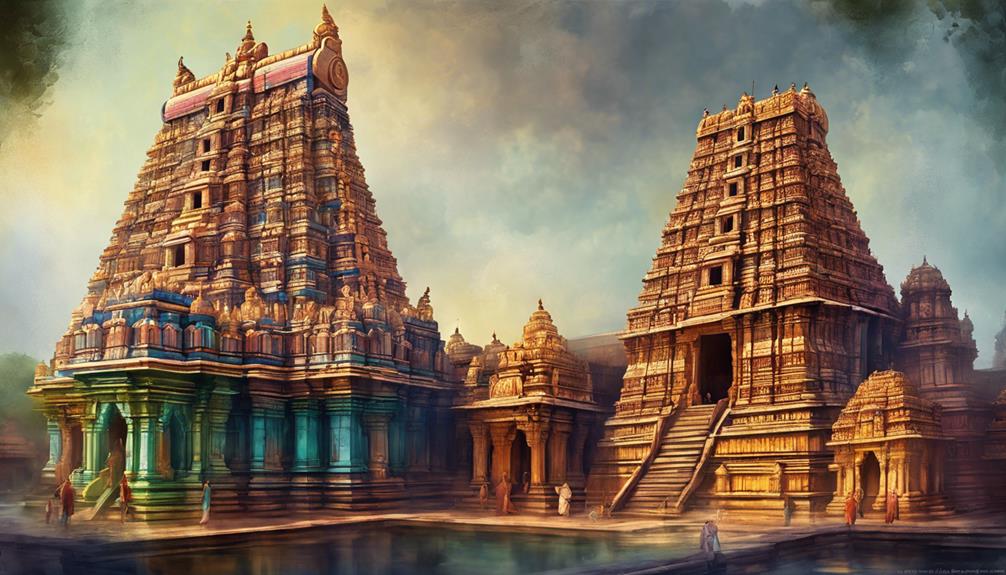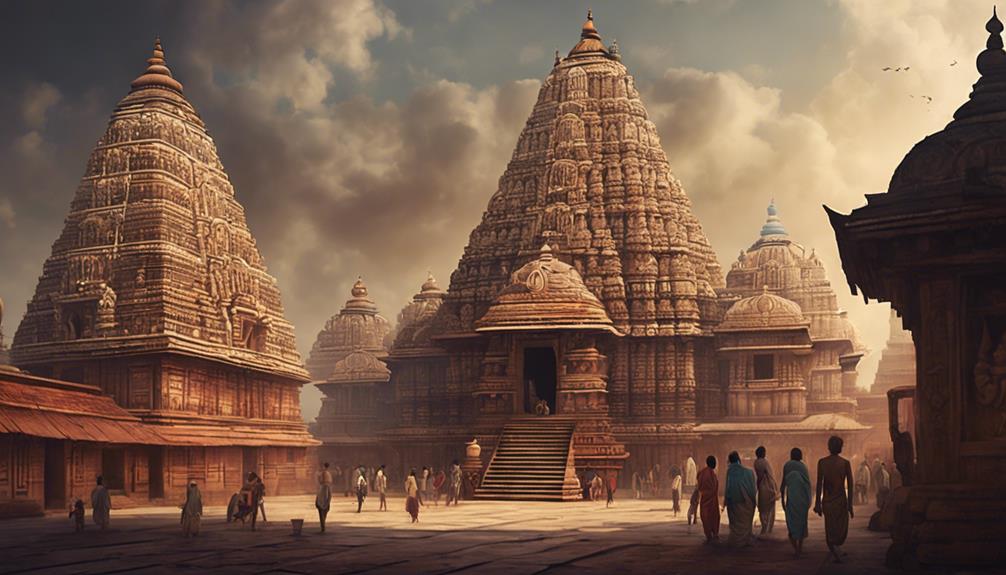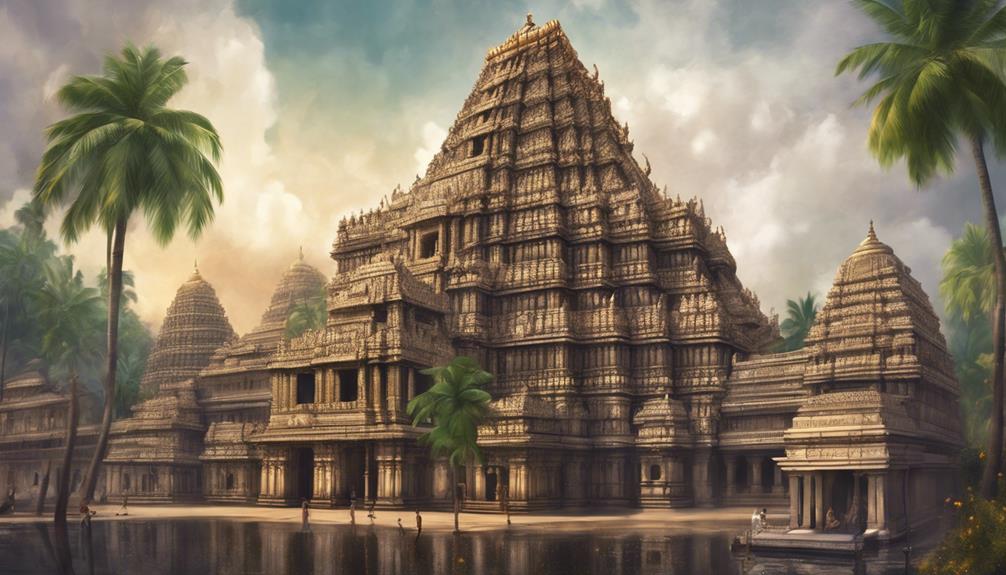Discover the essence of devotion and architectural marvels at the major temples dedicated to Lord Vishnu in India. The Venkateswara Temple in Tirupati stands as the most revered, drawing millions on pilgrimage yearly for seva and divine connection. The Badrinath Temple in Uttarakhand, established in the 8th century, symbolizes historical preservation through its Vedic style architecture. Srirangam's Ranganathaswamy Temple boasts a vast complex reflecting Dravidian grandeur, inviting devotees for blessings and rituals. Dwarkadhish Temple in Dwarka epitomizes architectural splendor and tranquil worship.
The Jagannath Temple in Puri blends religious fervor with cultural heritage. Each temple carries a unique significance worth exploring further.
Table of Contents
Key Takeaways
- Venkateswara Temple, Tirupati: Most visited, offers seva, focal point for Vishnu devotees.
- Badrinath Temple, Uttarakhand: Historical significance, Vedic architecture, preserved cultural heritage.
- Ranganathaswamy Temple, Srirangam: Revered, Dravidian architecture, vast temple complex.
- Dwarkadhish Temple, Dwarka: Architectural grandeur, rooted in rituals, cultural importance.
- Jagannath Temple, Puri: Renowned pilgrimage site, blend of fervor and splendor, cultural heritage symbol.
Venkateswara Temple, Tirupati
The Venkateswara Temple in Tirupati stands as one of the most revered and visited temples dedicated to Lord Vishnu in India. Each year, millions undertake the arduous Tirupati pilgrimage to seek the blessings of Lord Venkateswara and to have a darshan, a glimpse of the deity.
The temple's significance lies not only in its spiritual importance but also in the opportunities it provides for devotees to engage in seva, selfless service. Devotees can participate in various seva activities such as assisting in the Prasadam distribution, where sanctified food is offered to the deity and then distributed to the pilgrims. This act of service is considered highly meritorious and is a way for devotees to express their devotion and gratitude towards the deity.
The Venkateswara Temple isn't just a place of worship; it's a center of community involvement and spiritual growth, making it a focal point for Vishnu devotees across the country.
Badrinath Temple, Uttarakhand
Badrinath Temple in Uttarakhand holds immense historical significance as one of the holiest pilgrimage sites for Hindus, believed to have been established by Adi Shankaracharya in the 8th century.
The temple's architectural marvel is evident in its distinct Vedic style, with intricate carvings and sculptures that showcase the rich heritage and culture of ancient India.
Visitors are captivated by the serene beauty of the temple's surroundings, nestled amidst the majestic Himalayan peaks, adding to the spiritual aura of this sacred place.
Historical Significance of Badrinath
Nestled amidst the tranquil Himalayan mountains, the ancient temple complex of Badrinath in Uttarakhand holds a rich tapestry of historical significance. Badrinath isn't just a place of religious pilgrimage; it stands as a symbol of historical preservation and cultural significance.
The temple's roots date back to ancient times, making it a significant site for those interested in unraveling the historical layers of India. Over the centuries, Badrinath has played an essential role in shaping spiritual beliefs and practices, drawing devotees seeking solace and enlightenment.
The temple's existence is intertwined with the fabric of Indian history, making it a cornerstone of religious heritage and a tribute to the enduring power of faith.
Architectural Marvel of Badrinath
With its intricate carvings and towering spire, the architectural marvel of Badrinath Temple in Uttarakhand showcases a blend of ancient craftsmanship and spiritual grandeur. The temple's incredible architecture reflects a deep spiritual significance, drawing devotees and tourists alike to witness its beauty.
Badrinath Temple isn't only a place of worship but also a cultural heritage site, preserving centuries-old traditions and architectural techniques. The detailed craftsmanship seen in every corner of the temple speaks volumes about the dedication of the artisans who built it.
This iconic temple isn't just a religious site; it stands as a testimony to the religious practices followed by generations, making it a significant pilgrimage destination for Lord Vishnu devotees.
Ranganathaswamy Temple, Srirangam

The Ranganathaswamy Temple in Srirangam stands as one of the most revered and significant temples dedicated to Lord Vishnu in India, attracting devotees from far and wide. The temple's architecture is a stunning display of Dravidian style, with its towering gopurams, intricate carvings, and expansive courtyards. The temple complex is vast, covering an area of around 156 acres and is surrounded by seven concentric walls. Each wall has impressive gateways leading devotees into the inner sanctum where the presiding deity, Lord Ranganatha (a reclining form of Lord Vishnu), resides.
The religious rituals performed at the Ranganathaswamy Temple are steeped in tradition and spirituality. The temple follows a strict schedule of daily rituals, including elaborate puja ceremonies, abhishekams, and processions of the deity. Devotees participate in these rituals with deep devotion, seeking blessings, and divine grace.
Dwarkadhish Temple, Dwarka
Dwarkadhish Temple in Dwarka epitomizes the essence of devotion and architectural grandeur intertwined harmoniously in a sacred space dedicated to Lord Vishnu. The temple's history dates back centuries, with its construction originally credited to Lord Krishna's great-grandson, Vajranabha. Over time, the temple has undergone numerous renovations and conservation efforts to preserve its sanctity and historical significance.
Religious practices at Dwarkadhish Temple are deeply rooted in rituals that devotees follow with unwavering faith. Pilgrims from all over the country flock to this revered site to seek blessings and immerse themselves in the spiritual aura that pervades the temple complex. The temple's architecture, characterized by intricate carvings and ornate structures, adds to the overall divine ambiance, creating a tranquil environment for worship and reflection.
As one of the major pilgrimage sites for followers of Lord Vishnu, Dwarkadhish Temple holds immense cultural and religious importance in India. Its significance extends beyond being a place of worship; it stands as a proof of the enduring legacy of Lord Krishna and the profound impact of devotion in Hinduism.
Jagannath Temple, Puri

Jagannath Temple in Puri, a renowned pilgrimage site in India dedicated to Lord Vishnu's avatar Jagannath, showcases a blend of religious fervor and architectural splendor that captivates visitors from far and wide. The temple is famous for its elaborate rituals and traditions that have been followed for centuries. One of the most important rituals is the Rath Yatra, where the deities are paraded through the streets on grand chariots, attracting millions of devotees.
Puri's Jagannath Temple plays a vital role in pilgrimage tourism, drawing devotees and tourists alike, thereby contributing significantly to the local economy. The temple complex, with its towering spires and intricate carvings, stands as a symbol of Odisha's rich cultural heritage and architectural prowess.
The temple's rituals and traditions not only uphold the spiritual essence of the site but also serve as a cultural cornerstone for the local community. The vibrant atmosphere, coupled with the religious significance, makes Jagannath Temple a must-visit destination for those seeking a deep connection with Lord Vishnu and Indian traditions.
Varadharaja Perumal Temple, Kanchipuram
Nestled in the historical city of Kanchipuram, Varadharaja Perumal Temple stands as a remarkable demonstration of the architectural and spiritual heritage of South India. This temple, dedicated to Lord Vishnu as Varadharaja Perumal, showcases intricate Dravidian temple architecture with its towering gopurams, pillared halls, and ornate sculptures. The temple's main deity, Varadharaja Perumal, is depicted in a majestic reclining posture symbolizing peace and prosperity.
The Varadharaja Perumal Temple holds immense cultural significance in Kanchipuram, known as the 'City of Temples.' It's one of the Divya Desams, the 108 temples revered in the Vaishnavite tradition. The temple's annual Brahmotsavam festival attracts devotees and tourists from far and wide, adding vibrancy to the city's cultural tapestry. As a center of religious and architectural importance, the Varadharaja Perumal Temple serves as a spiritual oasis for those seeking solace and divine blessings in the bustling town of Kanchipuram.
Sree Padmanabhaswamy Temple, Thiruvananthapuram

Situated in the lively city of Thiruvananthapuram, the Sree Padmanabhaswamy Temple stands as a magnificent symbol of Kerala's rich cultural and religious heritage. This temple gained worldwide attention due to its temple treasures, comprising hidden wealth worth billions, discovered in its underground vaults. The treasure trove found here has added an air of mystery and intrigue to the temple's already illustrious history.
The Sree Padmanabhaswamy Temple not only houses these riches but also serves as an essential center for Trivandrum culture and local traditions. The architectural grandeur of the temple, with its intricate carvings and towering gopuram, reflects the artistic prowess of the region. Devotees and tourists alike are drawn to the temple not only for its spiritual significance but also to witness the fusion of Dravidian and Kerala styles of architecture.
Exploring the Sree Padmanabhaswamy Temple allows you to investigate the depths of history and tradition, while marveling at the opulence hidden within its sacred walls.
Udupi Sri Krishna Matha, Karnataka
The Udupi Sri Krishna Matha in Karnataka stands as a revered pilgrimage site known for its historical significance and architectural beauty. This matha, established by the saint Madhvacharya in the 13th century, holds immense cultural heritage and spiritual significance for devotees. The matha follows rigorous religious practices, including daily worship rituals that have been maintained for centuries.
The festival celebrations at Udupi Sri Krishna Matha are vibrant and attract devotees from far and wide. The most famous festival is the 'Paryaya' festival, where the temple's management is handed over to a new pontiff every two years. This tradition has been carried out without interruption since the matha's inception.
The matha's architecture, with intricate carvings and a unique Rajangana structure, is a tribute to the rich heritage and craftsmanship of ancient India. Pilgrims not only come to worship but also to admire the beauty of this sacred place. The Udupi Sri Krishna Matha stands as a symbol of devotion, tradition, and unwavering faith for Lord Krishna's followers.
Frequently Asked Questions
Are There Any Specific Rituals or Ceremonies That Are Unique to Each of These Temples?
When you explore the major temples dedicated to Lord Vishnu in India, you'll encounter unique rituals, temple ceremonies, spiritual practices, divine offerings, sacred traditions, and religious customs that enrich your understanding and connection with the divine.
What Is the Historical Significance of These Temples in Relation to Lord Vishnu's Mythology and Legends?
Delving into the historical significance of these temples, you'll uncover profound mythological connections to Lord Vishnu's legends. Through intricate architecture and sacred rituals, these sites offer a tangible link to the divine narratives of ancient times.
How Do These Temples Contribute to the Cultural and Religious Landscape of India?
You'll find that these temples play an essential role in shaping the cultural and religious fabric of India. They stand as architectural marvels, offering spiritual experiences and serving as centers for religious practices that connect people to their faith.
Are There Any Notable Festivals or Events That Take Place at These Temples Throughout the Year?
Throughout the year, these temples host vibrant cultural celebrations and annual gatherings. People come together to honor their beliefs and traditions, adding to the rich tapestry of temple architecture and local customs.
How Do These Temples Attract Pilgrims and Devotees From All Over the Country and Even the World?
When you visit these temples, the rich history, intricate architecture, and sacred rituals create an immersive experience for pilgrims. Devotional practices, combined with the aura of spirituality, draw devotees globally, fostering a deep connection.
Conclusion
To summarize, the major temples dedicated to Lord Vishnu in India hold immense significance in Hindu culture and spirituality.
Each temple has its own unique history, architecture, and rituals that attract millions of devotees from around the world.
These temples serve as important pilgrimage sites where devotees can connect with the divine and seek blessings from Lord Vishnu.
Their grandeur and spiritual aura make them revered symbols of devotion and faith in the country.